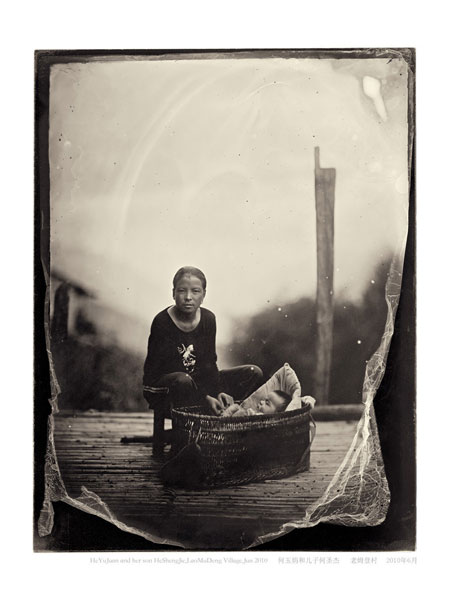
 |
|
"He Yujuan and her son He Shengjie" Lao Mu Deng Village, June 2010. Part of the "Simple Song" exhibit by Luo Dan [Photo/China.org.cn] |
The shooting process is even more arduous than developing the negatives. Since collodion plates have a low sensitivity to light, exposure times are long – from several seconds to a minute - even outdoors in bright sunlight. Long exposures necessitate the camera be mounted on a tripod. Subjects must stand still for a long time. Any movement will render the image out of focus. A soft portrait can work well in some instances, depending on the subject and artist's intention, but in most cases a sharp image is more desirable.
Yet a long shooting process also has its advantages, Luo said. Typically, when photographers take non-candid portraits outside of the studio, they capture the subject's feeling of being disturbed, he explained. But during a longer exposure time, tension dissipates, allowing the photographer to render a more accurate impression of the subject.
"You have to approach the person, explain what you are doing, and usually the person will start thinking too much even if he or she agrees to do the photo," Luo said. "But if enough time goes by, the person will eventually relax and appear completely natural. It is almost ceremonial."
In his two previous works "On the Road – 318" (2006) and "North, South" (2008), Luo examined the rift between Chinese people and their surroundings amid the changes brought on by modernization.
"As I traveled across China, I saw many people, regardless of financial status or occupation, drifting," he said. "So my work from this period tends to be critical of the subjects."
Disillusioned, Luo set out to create a more reverent, naturalistic body of work with "Simple Song." Indeed, its 30 sepia-tinged portraits, rich in tonal range, portray a robust agrarian people rooted to their land and communities. The remote rural setting and vintage photographic medium recall China at the twilight of the Qing Dynasty more than a century ago. The newest technology present is electricity – a lone dangling light bulb in a photo of villagers celebrating Thanksgiving.
Lest viewers think the villagers are totally estranged from contemporary civilization, Luo said that most of them have mobile phones and computers. But that's where the similarities with modern China end.
"These farmers live a harsh life the rest of us left behind long ago." he said. "I admire their perseverance, their calm in the face of frequent hardship."
Luo plans to continue experimenting with vintage photographic processes in the future. Amid the frenetic pace of change gripping China, he aims to capture a sense of permanence.
In an essay accompanying his "Simple Song" book, he wrote, "A friend asked me when he first saw these photos, 'When were these photos taken, a hundred years ago?' I answered: 'No, they were taken a hundred years from now.' "
A survey of Luo's work can be found online at luodanphoto.com.
Matthew Fulco is a freelance writer based in Shanghai.